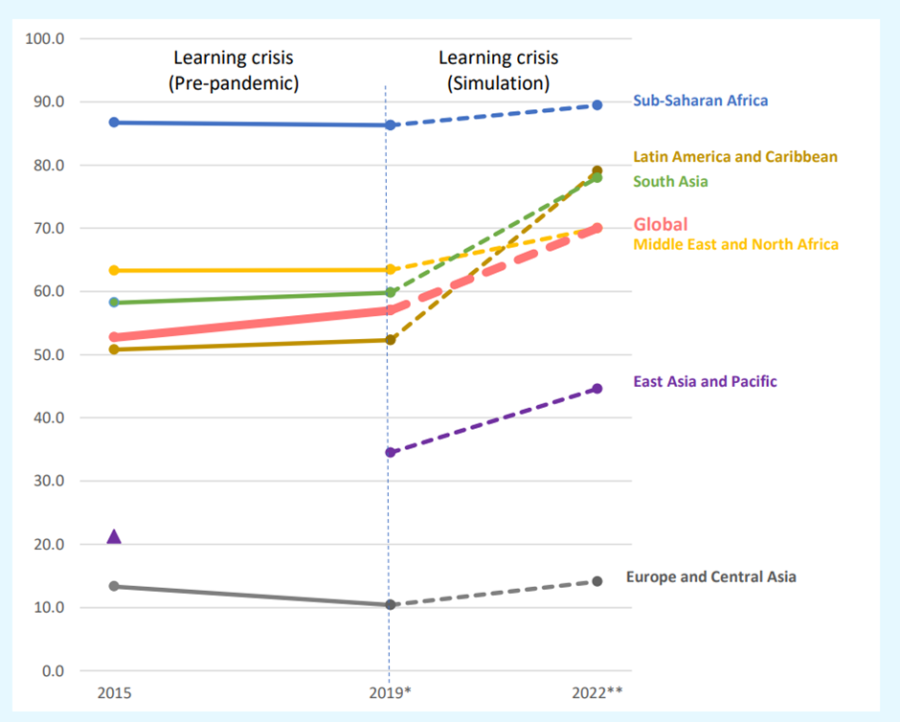World Leaders Fail to End Global Learning Poverty
Healthful Vitality | 12/08/2022 | World Leaders Fail to End Global Learning Poverty.

If children do not learn, it will have a long-lasting adverse impact on society. Thus, understanding learning poverty is essential. It is about understanding the severity of learning issues.
World leaders fail to end global learning poverty
It is a simple parameter that measures the number of children who are able to read by the age of 10 years. Here it is not just about schooling. Experience shows that in many nations, most children are going to school, and still, they have a high learning poverty prevalence.
Thus, for example, in South Asia, 80% of children are going to school. This naturally means that 20% are living in learning poverty. However, studies show that one-fourth of those attending school also live in learning poverty. Hence, the true value of learning poverty in South Asia is almost close to 60%.
Similarly, in developed nations like Europe and Central Asia, most children attend school, yet these areas have a learning poverty rate of above 10%. Learning poverty rates are alarmingly high in sub-Saharan Africa at almost 90%. Due to the higher population in developing nations, global learning poverty rates are also exceptionally high at nearly 70%.

Figure 1. Learning Poverty Globally and by Region—2015 and 2019, with 2022 Simulation Estimates. Source: https://www.unicef.org/media/122921/file/StateofLearningPoverty2022.pdf
It is also worth noting that global learning poverty rates rose considerably due to Covid-19. Again, this is related to school closures and other factors causing education disruption.
Why does understanding learning poverty matter?
Learning poverty may not immediately impact society, as it not only shows present issues but also indicates what to expect in the future. For example, if children cannot read by the age of 10, it will result in poor mental development. Hence, countries with higher learning poverty will continue to struggle with poverty even in the future.
Statistics show that most regions in the world need to take urgent measures to curb learning poverty, or else they cannot overcome poverty, and the quality of life will remain poor in those nations. WHO estimates that if learning poverty is not tackled, it will result in trillions of US dollars of loss for the current generation.
The causes of corruption in education
There are many reasons for the causes of corruption in education, including weak ethical norms and the poor rule of law, the complexity of education and lack of transparent governance, and the size and distribution of education (UNODC).
Accountability of leaders matters. Good governance drives accountability—poor governance influences ineffective leadership and corruption. The world needs accountable and inclusive institutions with widespread grassroots support to end corruption—the integrity and ethics of institutions matter. According to the World Economic Forum, you need to start with corruption to end poverty.
Related Article: Immediately End Corruption to End Poverty
How to tackle learning poverty? – World leaders fail to end global learning poverty
For a brighter future, it is vital to counter learning poverty. To tackle learning poverty, WHO recommends using a strategy named RAPID:
- Reach every child and ensure that they go to school. The first ten years of life are crucial to learning and have a long-term impact on mental development. Therefore, it is vital to start back-to-school campaigns even in developed economies.
- Assess learning frequently, as many of those attending school can still not read. Therefore, it is vital to create schools for children with special requirements.
- Prioritize teaching fundamentals. It means that instead of focusing on some advanced thing, the focus should be on teaching reading, writing, and basic math well.
- Increase instruction efficiency so that teachers can teach better and help children catch up with learning. This is especially important to overcome the harm done by Covid-19.
- Develop a strategy to improve mental health, which has been harmed due to Covid-19, thus worsening learning outcomes.
In short, it is vital to understand the threat posed by the learning crisis, especially the threat caused due to schooling disruption. Furthermore, it is crucial to understand that learning poverty has long-term implications.
Related Article: Ending Learning Poverty: All Stakeholders Are Invited
Additional Readings:
The State of Global Learning Poverty: 2022 Update. https://www.unicef.org/media/122921/file/StateofLearningPoverty2022.pdf
We are losing a generation. https://www.brookings.edu/blog/future-development/2022/01/28/we-are-losing-a-generation/
11 Facts about education and poverty in America. https://www.dosomething.org/us/facts/11-facts-about-education-and-poverty-america
Sounding the Alarm on Global Learning Poverty. https://www.triplepundit.com/story/2022/literacy-learning-poverty/754781
Poverty and education in East Africa. https://www.habitatforhumanity.org.uk/blog/2017/04/poverty-and-education-east-africa/
